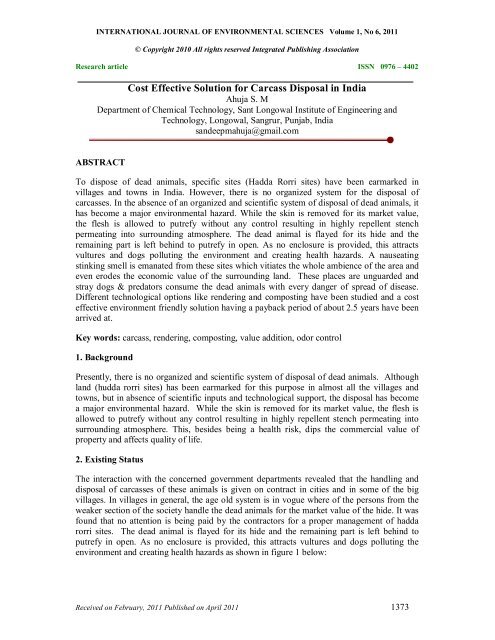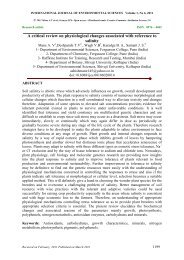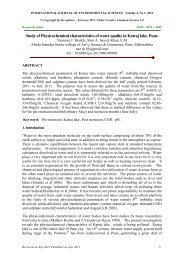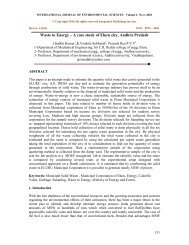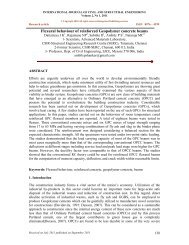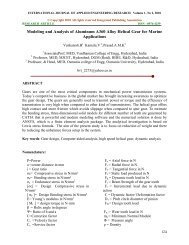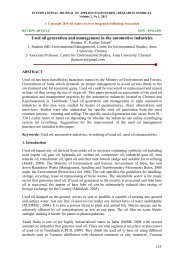Cost Effective Solution for Carcass Disposal in India - Integrated ...
Cost Effective Solution for Carcass Disposal in India - Integrated ...
Cost Effective Solution for Carcass Disposal in India - Integrated ...
You also want an ePaper? Increase the reach of your titles
YUMPU automatically turns print PDFs into web optimized ePapers that Google loves.
INTERNATIONAL JOURNAL OF ENVIRONMENTAL SCIENCES Volume 1, No 6, 2011<br />
© Copyright 2010 All rights reserved <strong>Integrated</strong> Publish<strong>in</strong>g Association<br />
Research article ISSN 0976 – 4402<br />
<strong>Cost</strong> <strong>Effective</strong> <strong>Solution</strong> <strong>for</strong> <strong>Carcass</strong> <strong>Disposal</strong> <strong>in</strong> <strong>India</strong><br />
Ahuja S. M<br />
Department of Chemical Technology, Sant Longowal Institute of Eng<strong>in</strong>eer<strong>in</strong>g and<br />
Technology, Longowal, Sangrur, Punjab, <strong>India</strong><br />
sandeepmahuja@gmail.com<br />
ABSTRACT<br />
To dispose of dead animals, specific sites (Hadda Rorri sites) have been earmarked <strong>in</strong><br />
villages and towns <strong>in</strong> <strong>India</strong>. However, there is no organized system <strong>for</strong> the disposal of<br />
carcasses. In the absence of an organized and scientific system of disposal of dead animals, it<br />
has become a major environmental hazard. While the sk<strong>in</strong> is removed <strong>for</strong> its market value,<br />
the flesh is allowed to putrefy without any control result<strong>in</strong>g <strong>in</strong> highly repellent stench<br />
permeat<strong>in</strong>g <strong>in</strong>to surround<strong>in</strong>g atmosphere. The dead animal is flayed <strong>for</strong> its hide and the<br />
rema<strong>in</strong><strong>in</strong>g part is left beh<strong>in</strong>d to putrefy <strong>in</strong> open. As no enclosure is provided, this attracts<br />
vultures and dogs pollut<strong>in</strong>g the environment and creat<strong>in</strong>g health hazards. A nauseat<strong>in</strong>g<br />
st<strong>in</strong>k<strong>in</strong>g smell is emanated from these sites which vitiates the whole ambience of the area and<br />
even erodes the economic value of the surround<strong>in</strong>g land. These places are unguarded and<br />
stray dogs & predators consume the dead animals with every danger of spread of disease.<br />
Different technological options like render<strong>in</strong>g and compost<strong>in</strong>g have been studied and a cost<br />
effective environment friendly solution hav<strong>in</strong>g a payback period of about 2.5 years have been<br />
arrived at.<br />
Key words: carcass, render<strong>in</strong>g, compost<strong>in</strong>g, value addition, odor control<br />
1. Background<br />
Presently, there is no organized and scientific system of disposal of dead animals. Although<br />
land (hudda rorri sites) has been earmarked <strong>for</strong> this purpose <strong>in</strong> almost all the villages and<br />
towns, but <strong>in</strong> absence of scientific <strong>in</strong>puts and technological support, the disposal has become<br />
a major environmental hazard. While the sk<strong>in</strong> is removed <strong>for</strong> its market value, the flesh is<br />
allowed to putrefy without any control result<strong>in</strong>g <strong>in</strong> highly repellent stench permeat<strong>in</strong>g <strong>in</strong>to<br />
surround<strong>in</strong>g atmosphere. This, besides be<strong>in</strong>g a health risk, dips the commercial value of<br />
property and affects quality of life.<br />
2. Exist<strong>in</strong>g Status<br />
The <strong>in</strong>teraction with the concerned government departments revealed that the handl<strong>in</strong>g and<br />
disposal of carcasses of these animals is given on contract <strong>in</strong> cities and <strong>in</strong> some of the big<br />
villages. In villages <strong>in</strong> general, the age old system is <strong>in</strong> vogue where of the persons from the<br />
weaker section of the society handle the dead animals <strong>for</strong> the market value of the hide. It was<br />
found that no attention is be<strong>in</strong>g paid by the contractors <strong>for</strong> a proper management of hadda<br />
rorri sites. The dead animal is flayed <strong>for</strong> its hide and the rema<strong>in</strong><strong>in</strong>g part is left beh<strong>in</strong>d to<br />
putrefy <strong>in</strong> open. As no enclosure is provided, this attracts vultures and dogs pollut<strong>in</strong>g the<br />
environment and creat<strong>in</strong>g health hazards as shown <strong>in</strong> figure 1 below:<br />
Received on February, 2011 Published on April 2011 1373
<strong>Cost</strong> <strong>Effective</strong> <strong>Solution</strong> <strong>for</strong> <strong>Carcass</strong> <strong>Disposal</strong> <strong>in</strong> <strong>India</strong><br />
Figure 1: A typical picture of hadda rorri site<br />
A render<strong>in</strong>g plant located at Ladhowal near Phillaur where dead animals are be<strong>in</strong>g processed<br />
daily to manufacture tallow, bone meal and meat meal was also studied. This plant, though<br />
commercially flourish<strong>in</strong>g, is a typical case of unscientific management and a major source of<br />
environmental degradation (Figure 2)<br />
Figure 2: Pen pans used <strong>for</strong> cook<strong>in</strong>g carcasses<br />
About 20 dead animals are processed daily. After desk<strong>in</strong>n<strong>in</strong>g whole carcass is boiled <strong>in</strong><br />
open big sized pan <strong>for</strong> 1416 hrs. The tallow is skimmed off and the effluents generated are<br />
allowed to stagnate on to surround<strong>in</strong>g land without any treatment. The bones and cooked<br />
meat is taken out. While the bones are sent to the bone meal plant, cooked meat is crushed<br />
and used as meat meal <strong>in</strong>gredient. The area around these plants is highly polluted and the<br />
offensive odor permeates <strong>for</strong> kilometers around. The remnants of animal parts are scattered<br />
all over the area which presents a ghastly site as shown <strong>in</strong> Figure 3<br />
Figure 3: Organs of the dead animals be<strong>in</strong>g disposed of <strong>in</strong> open<br />
Ahuja S. M<br />
International Journal of Environmental Sciences Volume 1 No.6, 2011<br />
1374
<strong>Cost</strong> <strong>Effective</strong> <strong>Solution</strong> <strong>for</strong> <strong>Carcass</strong> <strong>Disposal</strong> <strong>in</strong> <strong>India</strong><br />
3. Different technological options<br />
Literature survey revealed that there can be follow<strong>in</strong>g technological solutions to this problem:<br />
· Dry render<strong>in</strong>g (Workers Manual, 1999)<br />
· Compost<strong>in</strong>g (Herbert,1992)<br />
· Wet render<strong>in</strong>g (Brent et al., 2004)<br />
The dry render<strong>in</strong>g process is as such very expensive and hence it is not economically feasible.<br />
The compost<strong>in</strong>g process has been implemented successfully is some countries (Compost<strong>in</strong>g<br />
guide,2005) however, there are many operational problems and it has not been successful any<br />
where <strong>in</strong> <strong>India</strong>. Discussions with experts revealed that the Central Leather research <strong>in</strong>stitute<br />
has set a wet render<strong>in</strong>g plant <strong>in</strong> kanpur which is work<strong>in</strong>g efficiently <strong>for</strong> the last five years.<br />
Although this plat was located <strong>in</strong> the residential area yet, there was no offensive odor <strong>in</strong> the<br />
surround<strong>in</strong>gs. Besides conta<strong>in</strong><strong>in</strong>g pollution the plant has a pay back period of about 2.5 years<br />
due to recovery of bye products like, sk<strong>in</strong>, hide, tallow, bone meal, meat meal and bone and<br />
meat meal etc. Wet render<strong>in</strong>g along with the details of the plant have been described as under.<br />
4. Wet render<strong>in</strong>g Process<br />
Wet render<strong>in</strong>g <strong>in</strong>volves removal of hides/sk<strong>in</strong> at the flay<strong>in</strong>g yard from the <strong>Carcass</strong>, separation<br />
of rumen contents and horns and hooves. The rest of the animal body consist<strong>in</strong>g of flesh,<br />
tissues and bones is cooked <strong>in</strong> a cooker <strong>for</strong> obta<strong>in</strong><strong>in</strong>g tallow and cooked meat and bones.<br />
Limited amount of water is added <strong>in</strong> the cooker <strong>for</strong> the production of steam. The separation<br />
of cooked meat from bones is carried out manually. The separated bones are crushed <strong>in</strong> the<br />
bone crusher <strong>for</strong> obta<strong>in</strong><strong>in</strong>g bone meal. The separated cooked meal is generally sun dried.<br />
However, dur<strong>in</strong>g ra<strong>in</strong>y season this meat is first m<strong>in</strong>ced <strong>in</strong> the meat m<strong>in</strong>cer and then dried <strong>in</strong> a<br />
rotary dryer. The dried meat is pulverized <strong>in</strong> the pulverizer <strong>for</strong> produc<strong>in</strong>g meat meal. The<br />
meat meal can also be mixed with bone meal <strong>for</strong> mak<strong>in</strong>g meat cum bone meal. The various<br />
unit operations <strong>in</strong>volved <strong>in</strong> a typical wet render<strong>in</strong>g plant are enunciated below:<br />
4.1 Cook<strong>in</strong>g operation<br />
The cook<strong>in</strong>g vessel is based on the pr<strong>in</strong>ciple of an autoclave. It is made up of a metallic drum<br />
with circular per<strong>for</strong>ated plate that rests on three angular supports. The outer surface of the<br />
vessels is lagged with asbestos to prevent loss of heat. The asbestos is covered with th<strong>in</strong><br />
metallic sheet to avoid soak<strong>in</strong>g.<br />
Figure 4: Pressure cooker <strong>for</strong><br />
boil<strong>in</strong>g of meat and Bones<br />
Figure 5: Wire mesh<br />
conta<strong>in</strong>er <strong>for</strong> fill<strong>in</strong>g the meat<br />
Ahuja S. M<br />
International Journal of Environmental Sciences Volume 1 No.6, 2011<br />
1375
<strong>Cost</strong> <strong>Effective</strong> <strong>Solution</strong> <strong>for</strong> <strong>Carcass</strong> <strong>Disposal</strong> <strong>in</strong> <strong>India</strong><br />
Figure 6: Arrangement <strong>for</strong> load<strong>in</strong>g and unload<strong>in</strong>g of pressure cooker<br />
The top end of the vessel is provided with a flange and a groove. A water level gauge and a<br />
draw off valve have been provided. The photographs of a typical render<strong>in</strong>g pressure cooker<br />
along with its <strong>in</strong>ner details are shown <strong>in</strong> Figures. 4, 5 and 6.<br />
4.2 Extraction of tallow<br />
The slurry conta<strong>in</strong><strong>in</strong>g tallow is colleted <strong>in</strong>to an open pan from the render<strong>in</strong>g vessel. It is<br />
allowed to cool so that fat will solidify on the top layer. Fat is scooped off and collected <strong>in</strong> a<br />
separate vessel. There are impurities such as water with soluble prote<strong>in</strong>s and some m<strong>in</strong>erals.<br />
Hence the fat conta<strong>in</strong><strong>in</strong>g water and other impurities has to be cooked <strong>in</strong> an open pan by<br />
add<strong>in</strong>g alum and salt. Water is allowed to get evaporated and then purified tallow is<br />
collected.<br />
The bones after cook<strong>in</strong>g become soft and pliable. These bones are separated from soft tissues<br />
manually by the workers. This separation is shown <strong>in</strong> Figure 7 & 8<br />
Figure 7: Meat and bones after boil<strong>in</strong>g<br />
Ahuja S. M<br />
International Journal of Environmental Sciences Volume 1 No.6, 2011<br />
1376
<strong>Cost</strong> <strong>Effective</strong> <strong>Solution</strong> <strong>for</strong> <strong>Carcass</strong> <strong>Disposal</strong> <strong>in</strong> <strong>India</strong><br />
Figure 8: Separation of bones and meat after boil<strong>in</strong>g<br />
5. <strong>Cost</strong> benefits analysis of proposed Render<strong>in</strong>g Process:<br />
The economic viability of this technology is <strong>for</strong> process<strong>in</strong>g at least four to five carcasses Per<br />
day. Consider<strong>in</strong>g only 50% of big size animals, 60 big size animals will be received <strong>in</strong> one<br />
month and around 700 big sized animals will be received per year. Thus, the cost benefit<br />
analysis is calculated consider<strong>in</strong>g only the big sized animals.<br />
The estimated fixed cost of a typical wet render<strong>in</strong>g plant <strong>for</strong> process<strong>in</strong>g 45 carcasses per day<br />
is Rs. 15.00 lacs and it requires an annual work<strong>in</strong>g capital of Rs. 4.00 lacs. The value<br />
addition due to recovery of various products is estimated as Rs. 9.6 lacs per annum. Thus,<br />
the net annual profit would be Rs. 5.6 lacs and such a plant has a payback period of 2.5 years<br />
only.<br />
6. Conclusion<br />
There are three technological options <strong>for</strong> disposal of carcass. These are dry render<strong>in</strong>g, wet<br />
render<strong>in</strong>g and compost<strong>in</strong>g. However, under <strong>India</strong>n conditions the best possible cost effective<br />
and environmentally solution is wet render<strong>in</strong>g. This will not only provide a practical solution<br />
<strong>for</strong> controll<strong>in</strong>g offensive odor pollution but will also have economic benefit to the poor<br />
people engaged <strong>in</strong> carcass handl<strong>in</strong>g by recovery of bye products like, sk<strong>in</strong>, hide tallow, bone<br />
meal and meat meal etc. This technology has an estimated pay back period of only 2.5 years.<br />
References<br />
1. Workers manual on carcass recovery and byproducts utilization, Central Leather<br />
Research Institute Adyar, Chennai, 1999.<br />
2. Compost<strong>in</strong>g animal mortalities of the farm, Herebert L Brodie Lewis E Carr,<br />
Department of Biological resources eng<strong>in</strong>eer<strong>in</strong>g University of Maryland College<br />
park, 1992.<br />
3. Compost<strong>in</strong>g facility Code No 317, Natural resources conservation service<br />
conservation practie standard December 1990.<br />
Ahuja S. M<br />
International Journal of Environmental Sciences Volume 1 No.6, 2011<br />
1377
<strong>Cost</strong> <strong>Effective</strong> <strong>Solution</strong> <strong>for</strong> <strong>Carcass</strong> <strong>Disposal</strong> <strong>in</strong> <strong>India</strong><br />
4. Whole animal compost<strong>in</strong>g of dairy cattle Michael Looper extension Dairy specialist,<br />
New Mexico State University May 2002.<br />
5. <strong>Carcass</strong> <strong>Disposal</strong>: A Comprehensive Review National Agricultural Biosecurity<br />
Center Consortium USDA APHIS Cooperative Agreement Project.<strong>Carcass</strong><br />
<strong>Disposal</strong> Work<strong>in</strong>g Group, Brent Auvermann ,Ahmad Kalbasi, An<strong>in</strong>dita Ahmed,<br />
Texas A & M University August 2004.<br />
6. Compost<strong>in</strong>g Animal Mortalities: a producer’s Guide, University of Saskatchewan,<br />
Canada, January 2005.<br />
7. Compost<strong>in</strong>g Deadstock a Producer’s Guide to <strong>Effective</strong> Mortality Management,<br />
1999.<br />
8. Dead Animal Compost<strong>in</strong>g H. M. Keener and D. L. Elwell, Harold M. Keener,<br />
Dept. of Food, Agricultural, and Biological Eng<strong>in</strong>eer<strong>in</strong>g, OARDC, 1680 Madison<br />
Avenue, Wooster, OH 44691.<br />
9. Rynk, R.(Ed.) 1992. Onfarm Compost<strong>in</strong>g Handbook, NRAES54. Northeast<br />
Regional Agricultural Eng<strong>in</strong>eer<strong>in</strong>g Service, Ithaca, N.Y. White, D.G., J.M.<br />
Regenste<strong>in</strong>, T. Richard and S. Goldhor. 1989.<br />
10. Report on Compost<strong>in</strong>g Animal Mortalities By Debra Elias Morse, July 2001,<br />
University of M<strong>in</strong>nesota. www.mda.state.mn.us<br />
Ahuja S. M<br />
International Journal of Environmental Sciences Volume 1 No.6, 2011<br />
1378


